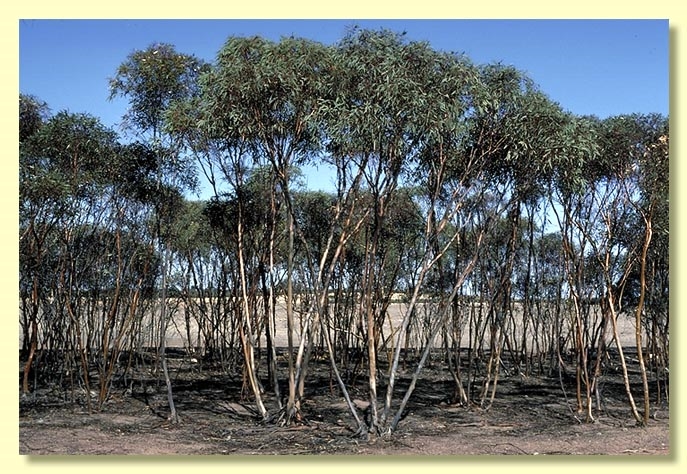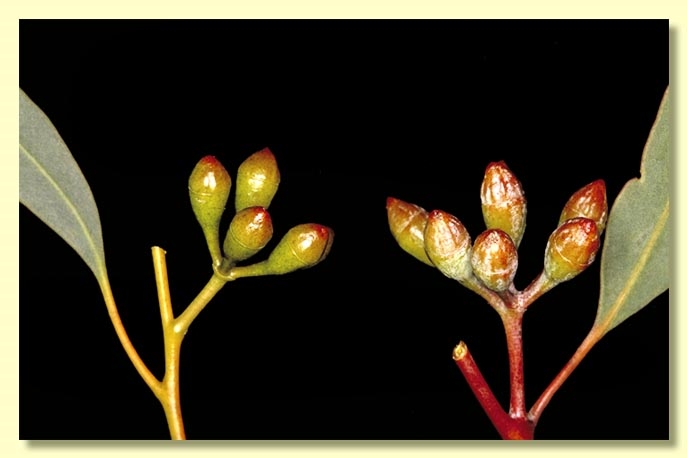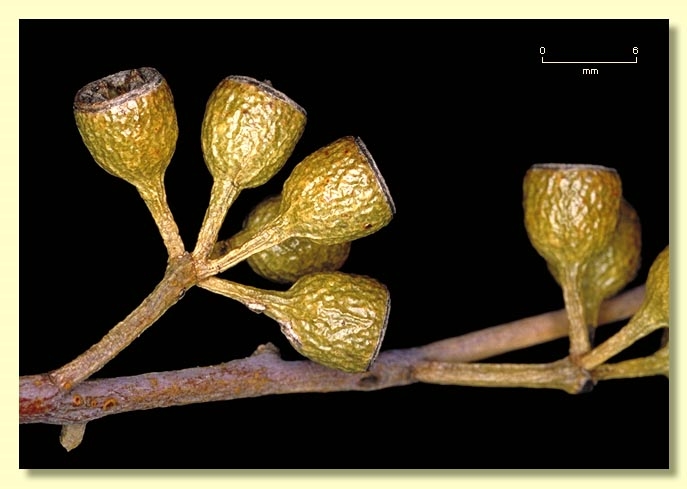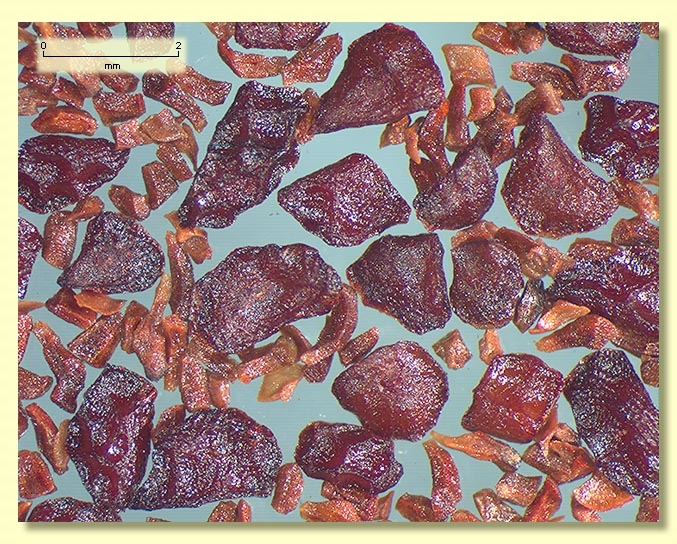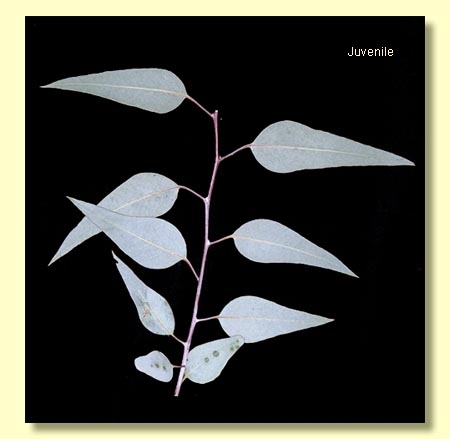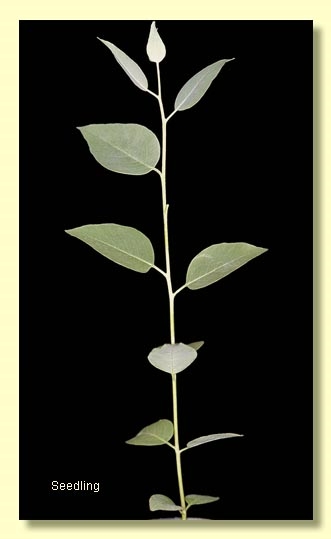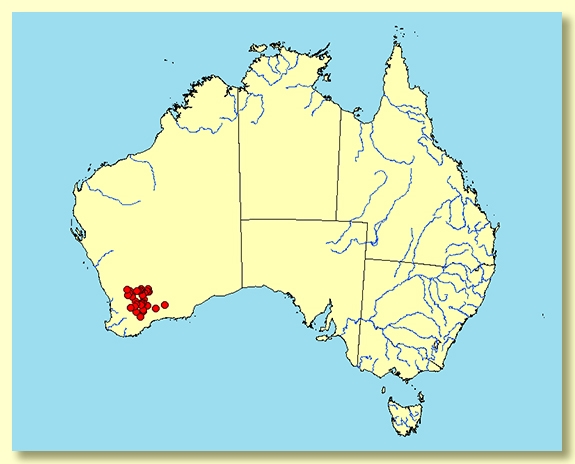Euclid - Online edition
Eucalyptus sheathiana
Eucalyptus | Symphyomyrtus | Dumaria | Rufispermae
T: cultivated, King's Park, Perth, W.A., J.Sheath. s.n.; holo: PERTH.
Bark smooth throughout, white-grey over coppery, shedding in conspicuous long ribbons.
Older branchlets frequently glaucous, oil glands present in the pith.
Juvenile growth (coppice or field seedlings to 50 cm): stems square to rounded in cross-section, waxy; juvenile leaves always petiolate, opposite for 2 to 4 nodes then alternate, ovate to lanceolate, 7.5–12.5 cm long, 2.5–4 cm wide, greyish green.
Adult leaves alternate, petioles 1–2.8 cm long; blade usually lanceolate, (6.5)7.5–13.3 cm long, 0.8–1.8(3) cm wide, base tapering to petiole, margin entire, apex acute, dull, rarely slightly glossy, green to grey-green, side veins acute, reticulation dense to very dense, intramarginal vein close to or remote from margin, oil glands intersectional.
Inflorescence axillary unbranched, peduncles 0.5–2 cm long, buds 7, rarely more than 7, pedicellate, pedicels 0.3–0.7 cm long. Mature buds obovoid to pyriform (0.6–1.2 cm long, 0.4–0.7 cm wide), glaucous or not, scar present (outer operculum shed early), inner operculum usually conical, often radially striate (0.2–0.5 cm long), stamens inflexed, cuboid to wedge shaped versatile anthers, sub-dorsifixed, dehiscing by longitudinal slits, style long and straight, stigma rounded to tapering, locules 4(5), the placentae each with 4 vertical rows of ovules. Flowers creamy white.
Fruit pedicellate, pedicels 0.2–0.5 cm long, obconical to cupular or rarely slightly campanulate, 0.5–1 cm long, 0.5–0.8 cm wide, glaucous or not, disc usually descending vertically, valves 4(5), near rim level.
Seeds reddish brown and glossy, 1.2–3.5 mm long, flattened-ovoid and sometimes slightly angular in outline, dorsal surface shallowly reticulate, hilum ventral.
Cultivated seedlings (measured at ca node 10): cotyledons reniform; stems square or rounded in cross-section, glaucous; leaves always petiolate, opposite for ca 3 to 4 nodes then alternate, ovate, 3.5–7 cm long, 1.5–4.5 cm wide, glaucous over grey-green.
Flowering has been recorded in January, February, March and December.
A mallee or woodland tree (with lignotuber) endemic to Western Australia, found in the southern wheatbelt extending south-east from Wongan Hills to near Nyabing and Lake King, and immediately adjacent areas of the Goldfields. The bark is smooth and sheds by long strips that hang for a while as ribbons. The crown is usually dull-leaved with the branchlets, buds and young fruit usually glaucous.
In the classification of Brooker (2000) Eucalyptus sheathiana belongs in Eucalyptus subgenus Symphyomyrtus section Dumaria having these features: buds initially with two opercula the outer shed early, stamens strongly inflexed, ovules in 4 rows on the placentae and cotyledons reniform. Within section Dumaria the species belongs to a large sub-group of closely related species (series Rufispermae, 37 described species and subspecies) diagnosed by glandular pith in the branchlets, cuboid to wedge shaped versatile anthers, and by the reddish brown and glossy, flattish seeds which are unique to the series.
Eucalyptus sheathiana is close to E. obtusiflora, a mallee found north from Wongan Hills and Dongara to Shark Bay including offshore islands. The two species grade into one another and the trees or mallees may be unidentifiable to species in the Wongan Hills area. E. sheathiana has a conical operculum whilst E. obtusiflora has a flattened to rounded operculum and usually has thicker leaves and larger fruit. Both species vary in the amount of glaucescence which may be almost completely absent in E. obtusiflora.
E. sheathiana is also closely related to E. vittata , a recently described mallet species with glaucous branchlets, buds and fruits, occurring in the Norseman–Coolgardie area extending to Lake Deborah near Koolyanobbing and south to Varley. The mallets seem more delicate in appearance than typical E. sheathiana but until 2009 were included in E. sheathiana. E. vittata differs only in the lack of a lignotuber.
The problem botanists will have is that trees may sometimes be found growing near or among mallee stands of E. sheathiana, and are presumably that species, but checking to see if progeny (seedlings) develop lignotubers is the only way to be certain (if they lack a lignotuber presumably they are E. vittata ). Tall trees somewhat like E. sheathiana in the wheatbelt in the Merriden–Kellerberrin area and near Corrigen have much longer peduncles and pedicels and slightly longer fruit than are typical, and may be intermediate between this and E. obtusiflora subsp. cowcowensis.

